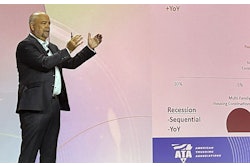The Internal Revenue Service bills itself as an excellent investment of taxpayer dollars since its $10.2 billion budget leads to a return of more than four times that much in enforcement revenues.
Remember a few years ago when everybody was down on the Internal Revenue Service? OK, so no one ever is really high on the IRS. But there was a time in the late 1990s when many in Congress had taken the nation’s tax collector to task for overzealous enforcement, and the agency responded by toning things down and soft-pedaling audits.
The results of the anti-IRS sentiment show in the agency’s enforcement revenues, which dropped from $38 billion in fiscal 1996 to just under $33 billion in fiscal 1999. For several years thereafter, enforcement revenues were basically flat.
Things have changed. Enforcement revenues have risen sharply to $43.1 billion in fiscal 2004 – a 15 percent increase over the previous year. After years of decline, audits of corporations with assets of $10 million and more climbed to 9,560 in fiscal 2004 from 7,125 the previous year. One in six of these large corporations were audited in fiscal 2004.
The increase in audits of large businesses as well as a special emphasis on abusive tax schemes contributed to a reduction of audits of small businesses. Audits of businesses with less than $10 million in assets dropped to 7,290 in fiscal 2004 from 13,680 the previous year. But IRS Commissioner Mark Everson promises to bring the audit rates up for small businesses as the IRS has done for large businesses.
Identifying risks
So your chances of drawing an audit may be rising. But what will the IRS look for? Although the agency’s emphasis may shift over time, the key issues for trucking companies hardly are a secret.
About 10 years ago, the IRS published an audit techniques guide to help its agents isolate key areas of concern in tax returns filed by companies in the trucking industry, including carriers, forwarders, brokers and others. This guide is one of many directed at specific industries.
According to the audit techniques guide, one of the biggest issues typically encountered in an audit of general freight carriers is the question of whether a driver is an independent contractor or an employee. Some of the other hot-button issues include the heavy vehicle use tax, capitalization of repairs or additional equipment and improper calculation of basis.
Some aspects of the audit techniques guide may be out of date, so you shouldn’t rely on it as your sole means of audit risk assessment. You should periodically seek out the advice of a certified public accountant or tax professional to identify risk areas.
Finally, if you don’t think your company is at risk of audit, consider your personal returns. Audits of taxpayers earning $100,000 totaled 195,000 in fiscal 2004 – 40 percent higher than the year before and 74 percent higher than in fiscal 2002. For all individual taxpayers, audits increased nearly 19 percent between fiscal 2003 and 2004 and almost 36 percent between fiscal 2002 and 2004.
Be careful out there.
To view a copy in PDF format of the IRS’s 114-page audit techniques guide for the trucking industry, click here.




![Volvo Vnl Sleeper Review[20]](https://img.ccjdigital.com/mindful/rr/workspaces/default/uploads/2025/11/volvo-vnl-sleeper-review20.lrVppY9UDR.jpg?auto=format%2Ccompress&fit=crop&h=167&q=70&w=250)



